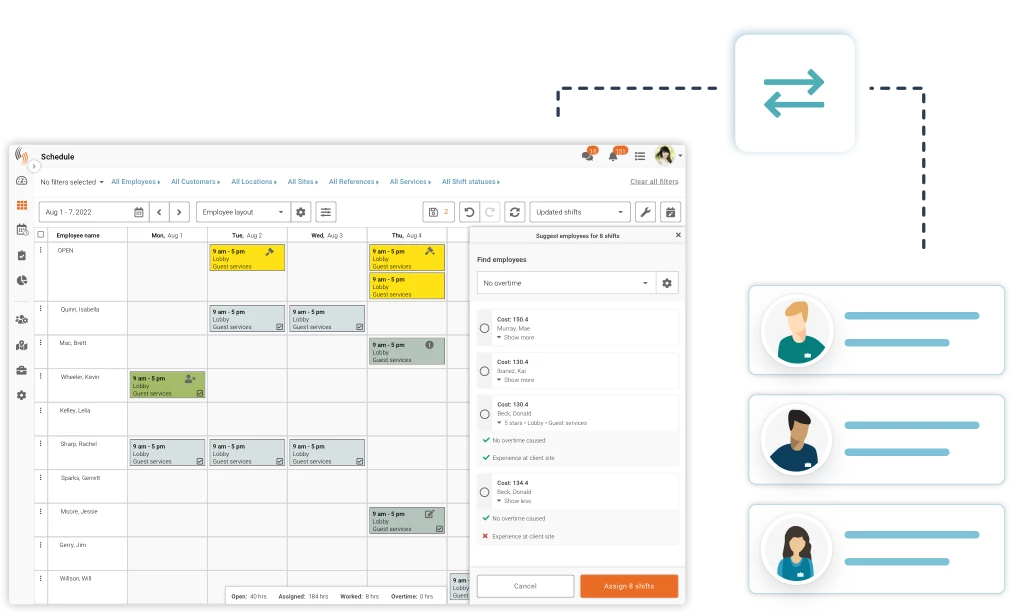Shift swaps are often a hindrance for schedule managers. However, in a time where employees are demanding more flexibility than ever, a shift swapping policy can set boundaries, and relieve stress for schedulers. No matter how much time and effort goes into creating the perfect employee schedule, conflicts will arise from time to time, and that’s life. With the right policies, procedures, and resources, shift swapping can be managed effectively, with minimal impact on those involved.
What is a Shift Swapping Policy? 
A shift swapping policy is the set of rules and processes that dictate how employees can swap shifts with their colleagues. It covers all aspects of shift swapping, like when it should be done, how it should be done, and who can swap with who. The shift swapping policy creates structure for both the employees, who swap shifts and the schedulers who oversee any changes.
Benefits of a Shift Swapping Policy for Employees
Employees are generally the people requesting a shift swap. Whether they have a family emergency, a personal appointment, or whatever the reason, shift swaps can be very useful. A shift swapping policy gives the employee clear guidance on how to approach the situation to achieve their desired results. It also gives them information on the employees that they are allowed to swap with, which makes it easier for them to arrange a swap.
With a clear shift swapping policy, the employee is more likely to get their swap, and be happy with their work schedule. It’s easier for them to achieve a healthy work life balance, and in turn an improved employee experience.
How a Shift Swapping Policy benefits Schedulers
Schedulers deal with enough when it comes to schedule management to manage shift swaps on top of everything else. An effective shift swapping policy sets boundaries for schedulers and gives them clear-cut guidance on how to handle them. Employees know what limits they have when it comes to shift swaps, which eliminates swaps that simply won’t be tolerated.
This means that schedulers are less likely to have to go back and forth with employees, and most shift swaps should be straightforward. Echoing back to the previous point, schedulers will also have happier employees that appreciate a policy that achieves work-life balance.
Other Benefits from an Effective Shift Swapping Policy
The right shift swapping policy can actually create other benefits for an organization as a whole.
Reduced No-Shows
When an employee cannot obtain a shift swap, they might resort to absenteeism. This is the worst-case scenario for employers. We have a whole blog post dedicated to the causes and costs of absenteeism, but essentially it affects productivity, employee retention, and employee engagement.
With an effective shift swapping policy, absences and no-shows relating to shift swaps are eradicated completely. When a shift swap is achieved, there is no downtime for the company, shifts are fully staffed, and operations can continue as normal, win-win!
Enhanced Workplace Culture

There are fewer denied requests, which creates a positive workplace culture. When expectations and guidelines are clear to everyone, there is a much lower chance of workplace conflict. Employees get the opportunity to build comradery, and this creates higher employee engagement overall.
What to include in a Shift Swapping Policy
Okay, so we’ve convinced you that you need a shift swapping policy. Great! Now, let’s address what should actually go into it, and why. In order for a shift swapping policy to be effective, it must be clear, comprehensive, and well communicated.
So, let’s look at how to create a shift swapping policy!
Who can Swap with who? Swap Eligibility
The first, and possibly most important policy to include is definitions of which employees can swap with each other. Every organization has multiple roles, qualifications, and levels of expertise. Your policy should make it very clear whether or not certain roles can be filled by alternative employees.
For example; can a bartender fill in for a server or vice versa? Can an unarmed guard fill in for an armed guard, and vice versa? Once these roles have been clarified, managers can rest in knowing all roles will be covered for every shift.
When can swaps be made?

When it comes to employees organizing their own coverage, it’s far better to ensure it happens in advance so that everyone is aware. Schedules can be updated, operations can be updated, and shift supervisors are aware. All of these things can be the difference between a swap going smoothly, or not.
Of course, there has to be room for emergencies. Outline general scenarios and procedures for last-minute swaps. Stress that these are a last resort and that reoccurrence will not be catered to. The whole mission of a shift swap policy is to make life easy. Following these guidelines will do exactly that.
Overtime and Hours Restrictions
The complexity of shift work makes shift swapping even more challenging. Employees can be contracted to work a set number of hours. There is also the whole issue of overtime. An employee wanting to swap a 7-hour shift for an 8-hour shift might just creep into overtime, or over their contracted hours.
This can cause problems, and add to payroll costs, which schedulers want to avoid. So, it is important to address hour limitations in your shift swapping policy, in order to avoid creating additional, unnecessary costs.
Shift Swapping Logistics
Finally, break down a simple, clear procedure for employees to follow when they want to shift swap. Is there software that should be used? Are requests made on paper? Do employees arrange their own swaps and then come to management?
There are a lot of moving parts that should be addressed in this section.
Celayix employee scheduling software has multiple tools that can help with shift swapping. While there is no “shift swap” feature, schedulers can allow employees to drop shifts. With Celayix, schedulers can create rules around shift dropping that make shift swapping easy and stress-free.
Celayix Shift Dropping
Once a scheduler enables drop shifts, they must decide on a deadline. There are three options for this, they can choose the number of hours before the shift starts, days, or they can specify a certain date. This is the deadline for when a shift can no longer be dropped. This ensures that no shift will be left uncovered, and there will be no last-minute scramble.
Schedulers also have control over what happens when a shift is dropped;
- Send shift drop for approval
- Publish dropped shift for self-scheduling
- Publsh dropped shift for shift bidding
- Set shift to “Open” status
- Create time-off record based on shift drop
This helps you automate your shift swapping and schedule management. Generally, when it comes to shift swapping, flexible scheduling options like shift-bidding or self-scheduling is used. This allows other team members to claim/express interest in the open shift. In the scenario of a shift that has been coordinated outside of the software, the employee who claims the dropped shift can drop the shift they want to be covered.
Once changes have been made and finalized, the updated schedule can be distributed in a matter of seconds to all employees and schedulers. Celayix also has a Find Replacement feature for those last-minute shift swap requests, which will generate a list of available and qualified employees. Notifications can be sent instantly for employees to pick up the shift, all without the phone even being lifted.
Overall, Celayix employee scheduling software can make shift swapping an absolute breeze. No more unrecorded conversations, unnecessary paperwork, or manual shift swapping. Let automation do the heavy lifting for you. If you’d like to hear more about Celayix software, reach out to a Solutions Advisor today for a free, custom demo.







